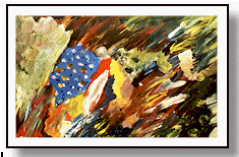ART Bridges-Hildegard Center: Emotion Painting
ART Bridges-Hildegard Center: Emotion Painting
A Copyrighted Activity Re-Posted with Permission from Andrea Mulder-Slater and KinderArt ®http://www.kinderart.com/painting/emotion.shtml
With an Additional Link to Emotions Color Wheel A Copyrighted Resource Link Posted with Permission from Do2Learn
http://www.do2learn.com/organizationtools/EmotionsColorWheel/index.htm

Image of Abstract painting
Objectives:
The participants will:
1. Reflect on the various emotions that are part of their personalities and experiences
2. Discuss how those emotions can be represented through color and lines in art
3. Create art using the themes of emotion, color and lines to create their own art
Audiences:
Andrea Mulder-Slater (creator of www.KinderArt.com ) designed this lesson to be used with children ages 5 and older. However, this lesson can be easily adapted to work with individuals of all ages as a way of identifying and expressing emotions. Participants will gain an understanding of how much of a role emotion plays in art-making as they create paintings based on feelings.
Vocabulary: image, feeling, emotion, idea, expression, color, texture, line, imagine, create, change, evolve, happy, sad, angry, excited, alone, bright, dull, acrylic, tempera, experience, share, design
Supplies/Materials:
- a large sheet of heavy paper (or canvas) for each participant
- acrylic paint (for older students)
- tempera paint - or crayons (for younger students)
- paintbrushes
- water
- containers
- mixing trays (could be Styrofoam trays or sheets of old cardboard)
- paper towels
- newspapers
- old shirts or painting smocks
- music (various styles)
- scrap newsprint
- pencils
Class Instructions:
1. Talk with your class about emotion. What does the word emotion mean? What kinds of emotions do we experience on a day-to-day basis?
2. Talk about color. How do certain colors make us feel? Why?
3. Talk about line. What kinds of lines are there? Straight, jagged, squiggly, zig-zag, etc.
4. Warm up by having students draw lines (using pencil on newsprint) based upon certain feelings. For example, ask the class to draw “happy” lines, “angry” lines, etc.
5. You can also encourage your students to draw lines based on the music they are hearing (e.g. jazz, classical, pop etc.).
6. Once everyone is "warmed up" begin working with the paint. Make sure each student has a paintbrush, water and access to at least the three primary colors (red, yellow and blue).
7. Give a quick demonstration of how paints are used properly (always clean brushes before dipping into a new fresh color ... treat the brushes well by not squishing them down on the paper etc. Also, review color mixing (yellow + blue = green; red + yellow = orange; red + blue = violet).
8. Everyone can then decide on an emotion or feeling which they will express using various paint colors, lines, textures and shapes.
9. Allow your participants to take as long as they need to create the final work, encouraging them to stand back from time to time to have a really good look at what they are doing. Is it moving in the direction they want it to? Are the desired feelings starting to emerge?
10. Remember, too, that this is a very intuitive and subjective exercise and as such the works should not be analyzed by the instructor, but rather by the “artists” themselves.
11. When the paintings are complete, hang them up and see how others interpret the work. Does everyone see similar emotions in the same works? Yes? No? Why? Refer to "How to Look at Art ".
Curriculum Connections:
History: Look at the works of various artists throughout time. While looking at the works, see if you can pick out any strong emotional feelings.
Language Arts: Write an emotion story or poem to go along with your painting.
Music: Think of rhythm and movement in music and compare the idea of "emotional music" with "emotional painting"
Additional Link Suggested by Hildegard:
For an excellent resource to accompany this lesson, please visit http://www.do2learn.com/organizationtools/EmotionsColorWheel/index.htm to access “The Emotion Color Wheel”. This resource will help your participants/clients/students learn to visually group feelings.
Heartfelt thanks to Andrea Mulder-Slater and KinderArt ® for granting permission to Hildegard Center for re-post this lesson. Founded in 1997, KinderArt ® is the largest collection of free art lessons on the Internet. What began in 1997 as a few helpful ideas for teachers and parents has since grown into an enormous collection of resources featuring thousands of tried and tested free lesson plans, ideas and resources which have been contributed by people from around the world. A truly interactive experience, KinderArt® provides an opportunity for parents, educators, artists, students and kids (of course) to have fun while exchanging ideas, finding information, conducting research and learning new things... all in one place. The goal of KinderArt® has been and always will be, to make art lessons and educational information accessible to people around the world. Please visit www.kinderart.com to access this outstanding resource!
Special thanks also to Do2Learn for granting permission to Link back to their website and the “Emotion Color Wheel” article. Do2learn provides thousands of free pages with social skills and behavioral regulation activities and guidance, learning songs and games, communication cards, academic material, and transition guides for employment and life skills. Please visit www.do2learn.com to learn more about this valuable resource!
